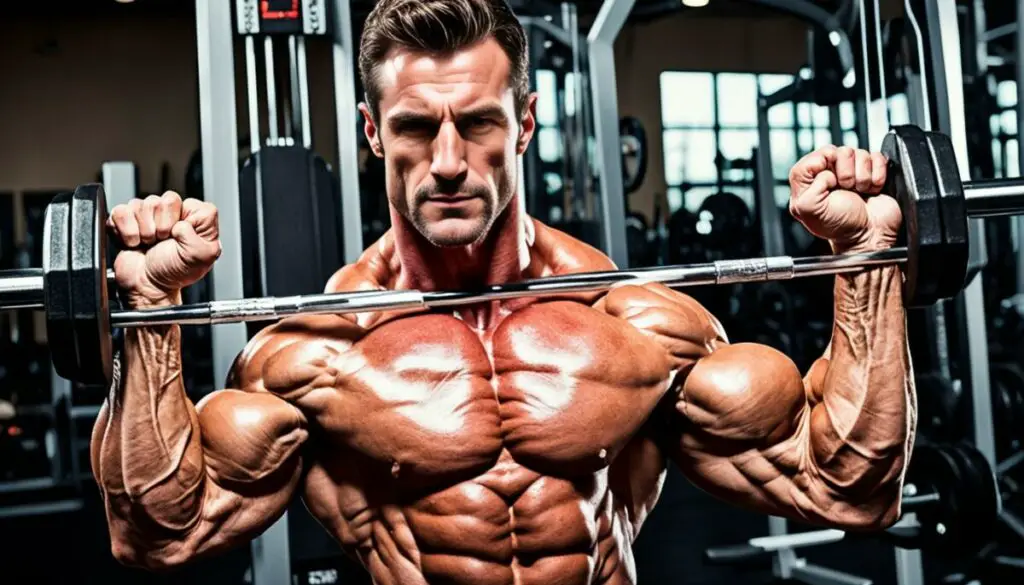Last Updated on 3 months by Francis
The reverse barbell curl is a powerful exercise that can help you achieve bigger forearms and sculpted arms. In this article, we will explore the reverse barbell curl and its benefits, as well as provide tips to perform the exercise effectively.
Unlike traditional barbell bicep curls, the reverse curl requires an overhand grip on the bar, with the back of your hands facing forwards. This variation places greater emphasis on your forearms, resulting in increased forearm strength and size. Additionally, the reverse barbell curl also targets the biceps, allowing you to build strength and achieve a more defined upper arm.
Contents
Key Takeaways:
- The reverse barbell curl targets the forearms and biceps, helping you build size and strength in these areas.
- Perform the exercise with proper form, using an overhand grip and keeping your back straight.
- Incorporate different grips to target different forearm muscles.
- Start with lighter weights to focus on muscle activation and control.
- Consider incorporating other reverse curl variations, such as dumbbell reverse curls or EZ bar reverse curls, for added variety in your workout routine.
What is a Reverse Curl and Why Should You Do It?

The reverse curl is a bicep curl variation that emphasizes the forearms and grip strength. Unlike traditional bicep curls, the reverse curl requires an overhand grip on the barbell, with the back of your hands facing forwards. This simple adjustment in grip placement shifts the focus to the muscles in the forearms, making it an excellent exercise for targeting and building both forearm and bicep muscles.
Why should you incorporate reverse curls into your strength training exercises? There are several compelling reasons:
1. Improved Grip Strength
A stronger grip can have a significant impact on your overall strength and performance in other exercises, as well as daily activities. The reverse curl specifically targets the muscles responsible for grip strength, helping you develop a powerful grip that can enhance your performance in various activities and sports.
2. Targeted Forearm Development
The reverse curl provides direct stimulation to the muscles in the forearms, leading to improved forearm development. Strong forearms not only contribute to an aesthetically appealing physique but also assist in activities requiring grip strength, such as lifting objects, performing pull-ups, and even using handheld devices.
3. Increased Bicep Strength and Size
The reverse curl engages the bicep muscles in a different way compared to traditional bicep curls. By using an overhand grip, the reverse curl places greater emphasis on the biceps, leading to increased strength and size in the upper arms. Incorporating reverse curls into your workout routine can complement other bicep exercises, helping you achieve well-rounded, defined arms.
Overall, the reverse curl is a valuable addition to your strength training routine, offering specific benefits for your forearms, grip strength, and bicep muscles. Whether you’re a beginner or an experienced lifter, including reverse curls can help you achieve your fitness goals and build a stronger, more balanced physique.
Physique Benefits of Reverse Curls and Differences with Dumbbell Variation

Including reverse curls in your workout routine can provide significant benefits for your overall physique, particularly in terms of forearm development. While traditional bicep curls primarily target the upper arms, reverse curls ensure that the forearms receive adequate stimulation, resulting in improved symmetry and a more aesthetically balanced appearance.
When comparing the barbell reverse curl to the dumbbell variation, there are some key differences to consider. With the barbell reverse curl, your hands are in a fixed position, which places a greater emphasis on the forearms. Conversely, with dumbbells, your wrists have more freedom to rotate, allowing for a greater range of motion.
While the barbell reverse curl may be more challenging due to the fixed hand position, it also eliminates the possibility of cheating the movement by externally rotating the wrists. This ensures that the forearms bear the majority of the load, leading to enhanced development and improved strength.
Overall, incorporating reverse curls into your routine can help you achieve better overall symmetry and forearm development, resulting in a more balanced and visually pleasing physique.
Tips for Performing the Perfect Reverse Curl

To maximize the effectiveness of your reverse barbell curl and achieve perfect form, follow these tips:
- Start with the right grip: Hold the barbell with an overhand grip, ensuring that your palms are facing towards you. This grip position will target the biceps and forearms effectively during the exercise.
- Maintain proper posture: Stand tall with your feet shoulder-width apart and your back straight. This position will help you engage the target muscles and prevent any unnecessary strain on your lower back.
- Control your upper arms: Keep your upper arms stationary throughout the movement. Avoid swinging or using momentum to lift the weight, as this can reduce the effectiveness of the exercise and increase the risk of injury.
- Perform a controlled curl: Bend your elbows to curl the bar up to shoulder height. Focus on a slow and controlled motion, squeezing your biceps and forearms at the top of the curl to maximize muscle activation.
- Use different grips: Experiment with different grips to target different forearm muscles. A standard grip with the thumb gripping the bar maximizes the weight you lift, while an open grip with the thumb resting on top of the bar places more emphasis on the muscle at the top of the forearm.
- Choose the right weight: When performing the reverse curl, it’s recommended to start with lighter weights. This allows you to focus on muscle activation and control throughout the exercise, reducing the risk of using improper form or sacrificing proper technique for heavier weights.
- Focus on the negative: While the concentric (lifting) portion of the reverse curl is important, equally emphasize the eccentric (lowering) portion. Lower the bar slowly and under control, engaging your muscles throughout the entire range of motion.
By following these tips, you’ll be able to perform the reverse barbell curl with perfect form, ensuring optimal muscle engagement and growth.
Additional Tips:
Here are a few additional tips to keep in mind when performing reverse curls:
- Ensure proper breathing throughout the exercise. Inhale as you lower the bar and exhale as you curl it up.
- Start with a warm-up set using lighter weights to prepare your muscles for the exercise.
- If you experience any discomfort or pain in your wrists or elbows, consider using wrist wraps or adjusting your grip to a more comfortable position.
- Include reverse curls as part of a well-rounded arm workout routine to target all the major muscles in your arms.
Reverse Curl Alternatives for Variation
While the reverse barbell curl is an effective exercise, it’s always beneficial to incorporate alternative variations into your arm workout routine. This not only adds variety to your training but also allows you to target different muscles from multiple angles. Here are some popular reverse curl alternatives:
- Dumbbell Reverse Curl: This variation allows for a greater range of motion and can be done with an open grip to specifically target forearm muscles.
- EZ Bar Reverse Curl: With the wrists in a slightly rotated position, this option may be gentler on the wrists and elbows.
- Flat Bar Cable Reverse Curl: If you prefer using a cable machine, this exercise provides constant tension throughout the movement.
- Zottman Curl: This hybrid move combines elements of the standard dumbbell curl, the dumbbell hammer curl, and the dumbbell reverse curl, offering a unique challenge for the arms and forearms.
By incorporating these reverse curl alternatives into your arm workout routine, you can diversify your training and maximize muscle engagement for greater overall development. Remember to choose the variations that best suit your goals and preferences.
Check out the table below for a quick comparison of the reverse curl alternatives:
| Exercise | Benefits |
|---|---|
| Dumbbell Reverse Curl | Greater range of motion, specific forearm targeting |
| EZ Bar Reverse Curl | Wrist and elbow comfort, slightly rotated position |
| Flat Bar Cable Reverse Curl | Constant tension with cable resistance |
| Zottman Curl | Hybrid exercise for comprehensive arm and forearm challenge |
Remember to choose the alternative exercises that align with your fitness goals and preferences. Incorporating these variations into your routine will give you the opportunity to challenge your muscles in new ways, leading to enhanced strength and development in both your arms and forearms.
Common Mistakes to Avoid and How to Improve the Reverse Curl
When it comes to performing the reverse curl, there are some common mistakes that you should avoid in order to ensure optimal effectiveness and safety. By addressing these mistakes and implementing key techniques, you can improve your reverse curl and get the most out of this exercise.
Mistake 1: Lifting Too Heavy
One of the most common mistakes people make when performing the reverse curl is lifting weights that are too heavy. While it’s important to challenge yourself, using too much weight can lead to improper form and an increased risk of injury. Instead, focus on using a weight that allows you to maintain proper technique throughout the exercise. Start with a weight that you can comfortably lift for the desired number of repetitions while maintaining good form.
Mistake 2: Using Momentum
Another mistake to avoid is relying on momentum to lift the weight during the reverse curl. This often happens when people use excessive swinging or jerking motions to move the weight. Using momentum takes the focus away from the target muscles – the biceps and forearms – and reduces the overall effectiveness of the exercise. Instead, concentrate on controlled and deliberate movements, focusing on the contraction of the muscles throughout the entire range of motion. This will ensure that you’re getting the most out of each repetition and maximizing your results.
Improving the Reverse Curl
To enhance the effectiveness of the reverse curl and maximize your results, here are some key tips:
- Use Different Grips: Experiment with different hand placements and grips to target various forearm muscles. A standard grip with the thumb wrapped around the bar emphasizes overall forearm strength, while an open grip with the thumb resting on top of the bar places more emphasis on the muscles at the top of the forearm.
- Lift Lighter Weights: Consider using lighter weights to focus on muscle activation and control. This will allow you to perform the exercise with strict form and ensure that the target muscles are fully engaged. As you progress and develop better control, you can gradually increase the weight.
By incorporating these strategies into your reverse curl routine, you can improve your form, maximize muscle engagement, and enhance your overall results. Remember, consistency and proper technique are key when it comes to any exercise, so take the time to master the reverse curl and reap the benefits it has to offer.
Benefits of Improving the Reverse Curl
Improving your reverse curl technique can lead to several benefits, including:
- Increased Muscle Activation: By avoiding common mistakes and using proper form, you can ensure that the target muscles – the biceps and forearms – are fully activated during the exercise. This leads to enhanced muscle development and strength.
- Reduced Risk of Injury: Lifting with proper form and using adequate weights reduces the risk of injury to the wrists, elbows, and other supporting muscles and tendons. This allows you to train consistently and progress safely.
- Improved Muscle Symmetry: By targeting the biceps and forearms more effectively, you can improve overall muscle symmetry in your arms. This results in a more balanced and aesthetically pleasing physique.
By focusing on avoiding common mistakes and implementing the tips mentioned above, you can take your reverse curl to the next level and achieve the desired results. Keep practicing, stay consistent, and enjoy the benefits of a stronger and more defined upper body.
Muscles Worked and Benefits of the Reverse Curl
The reverse barbell curl is a highly effective exercise that targets the biceps and forearms, providing a range of benefits for your upper body strength and aesthetics.
Muscles Worked:
| Muscle | Main Function |
|---|---|
| Biceps Brachii | Responsible for elbow flexion and contributes to overall arm strength and size. |
| Brachialis | Located underneath the biceps; activation of this muscle adds to forearm strength and helps with overall arm development. |
The reverse barbell curl engages these muscles in a unique way by placing emphasis on the forearms and grip strength. By incorporating this exercise into your workout routine, you can expect:
- Increased bicep and forearm strength
- Improved grip strength
- Enhanced muscle definition in the upper arms and forearms
This exercise is especially beneficial for those looking to build impressive forearms or improve their overall arm development. By targeting the biceps and forearms, the reverse curl helps create symmetry and balance, resulting in a more aesthetically pleasing physique.
So, if you’re aiming to strengthen your biceps while sculpting your forearms, the reverse barbell curl is a must-try exercise.
Who Should Do the Reverse Curl and How to Modify It
The reverse barbell curl is a versatile exercise that can benefit a wide range of individuals, from beginners looking to build arm strength to advanced lifters seeking variation in their routine. However, it’s important to listen to your body and make modifications if needed to ensure safety and effectiveness.
If you have an injury or experience discomfort in your biceps, elbows, or wrists, it’s recommended to consult with a healthcare professional before attempting the reverse curl. They can provide personalized guidance and suggest modifications that suit your specific needs and limitations.
One modification you can make to the reverse curl is using an EZ curl bar instead of a traditional barbell. The EZ curl bar has a more ergonomic design that reduces stress on the wrists and elbows, making it a suitable choice for individuals with joint issues.
Another modification option is to perform the reverse curl using dumbbells instead of a barbell. This allows for greater freedom of movement and provides a different stimulus to the muscles in your forearms and biceps. Additionally, using dumbbells can help improve coordination and balance.
Modifications for Reverse Curl:
| Modification | Description |
|---|---|
| EZ Curl Bar | Use an EZ curl bar instead of a barbell to reduce stress on the wrists and elbows. |
| Dumbbell Variation | Perform the reverse curl using dumbbells instead of a barbell to allow for greater range of motion and improved coordination. |
By modifying the reverse curl exercise to suit your individual needs, you can continue reaping the benefits of this effective arm and forearm exercise while minimizing the risk of injury or discomfort.
Conclusion
The reverse barbell curl is an essential exercise to include in your arm workout routine if you want to build impressive bicep muscles and enhance your forearm and grip strength. This exercise targets the upper arms and forearms, delivering noticeable improvements in strength, size, and definition. To maximize the benefits of the reverse curl, it’s crucial to maintain proper form and technique while avoiding common mistakes. Additionally, incorporating variations and modifications tailored to your individual preferences and needs can further enhance your results.
By regularly performing the reverse barbell curl with dedication and focus, you can take your upper body workout to the next level and achieve the strong and defined biceps and forearms you desire. Whether you’re a beginner or an advanced lifter, this exercise is suitable for individuals of all fitness levels. Remember to listen to your body and make any necessary modifications, especially if you have any existing injuries or discomfort in your biceps, elbows, or wrists.
So, if you’re ready to push yourself and build those bicep muscles and improve your upper body strength, incorporate the reverse barbell curl into your arm workout routine. With consistent effort and attention to detail, you’ll be on your way to achieving the strong and impressive arms you’ve always wanted.
FAQ
What is a reverse curl?
The reverse curl is a bicep curl variation that emphasizes forearm and grip strength. It involves using an overhand grip instead of an underhand grip, targeting the muscles in the forearms.
What are the benefits of reverse curls?
Reverse curls offer several benefits, including improved forearm development, increased grip strength, and enhanced size and definition in the upper arms and forearms.
How do I perform the reverse barbell curl with proper form?
To perform the reverse barbell curl, stand tall and hold the barbell with an overhand grip. Bend your elbows to curl the bar up to shoulder height, keeping your upper arms stationary and your back straight. Lower the bar slowly and repeat for the desired number of repetitions.
What are some alternatives to the reverse curl?
Some alternatives to the reverse curl include the dumbbell reverse curl, EZ bar reverse curl, cable reverse curl, and Zottman curl. These variations provide different challenges and target the muscles from various angles.
What are common mistakes to avoid when performing the reverse curl?
Common mistakes to avoid include lifting too heavy, using momentum to lift the weight, and improper form. It’s important to listen to your body, start with a weight that allows for proper form, and focus on muscle activation and control.
Which muscles are worked during the reverse curl?
The reverse curl primarily targets the biceps and forearms. The biceps brachii and brachialis muscles in the upper arms are heavily engaged during this exercise.
Who should do the reverse curl and how can it be modified?
The reverse curl can benefit a wide range of individuals, from beginners to advanced lifters. However, it’s important to modify the exercise if you have any injuries or discomfort in the biceps, elbows, or wrists. Different variations, such as using an EZ curl bar or dumbbells, can be used to accommodate individual preferences and limitations.








